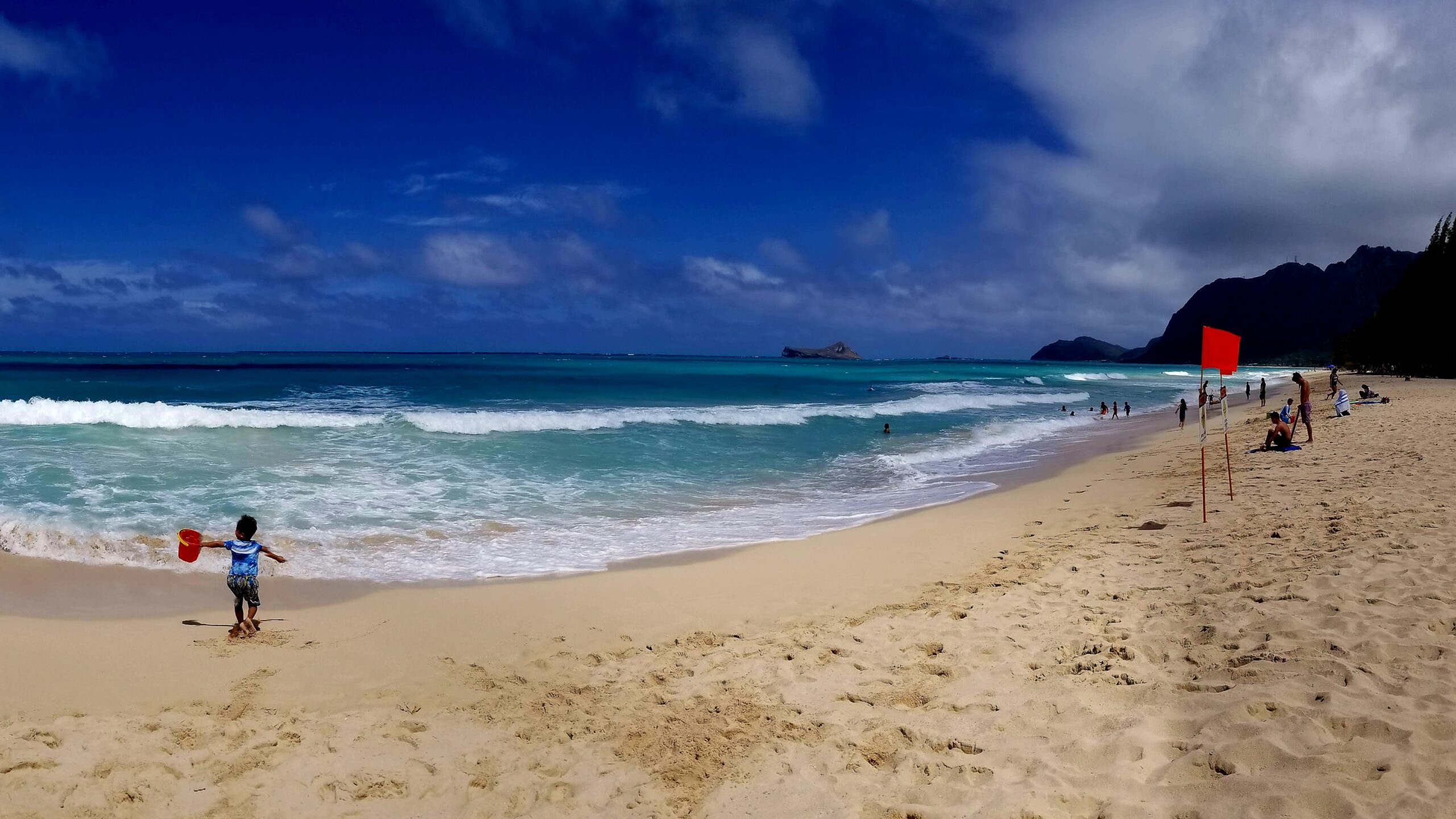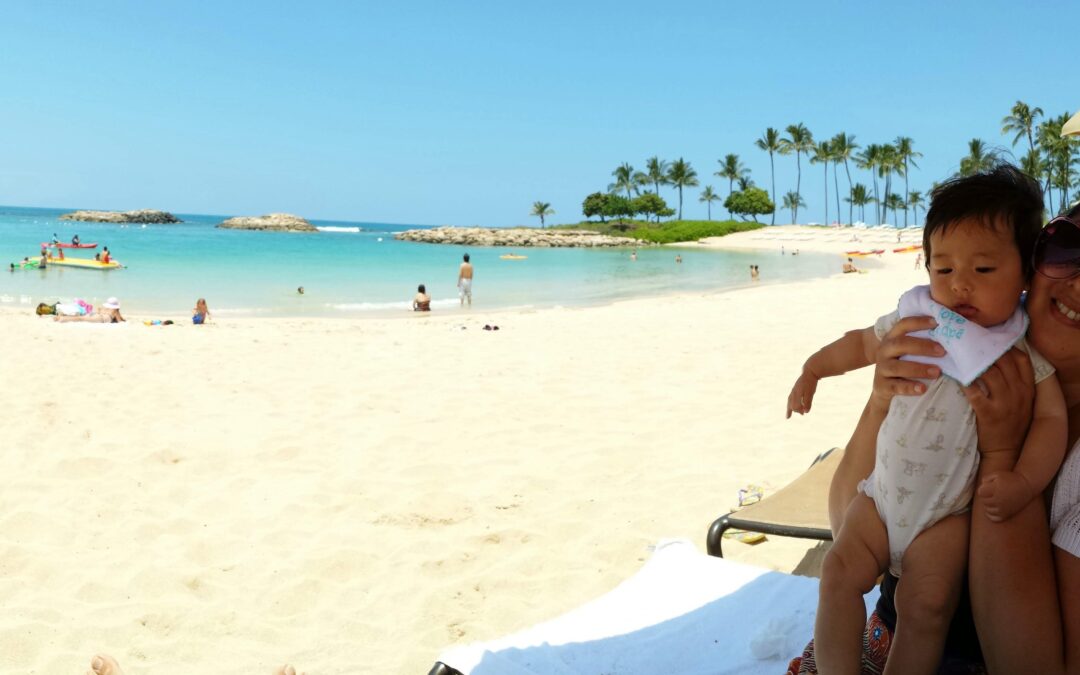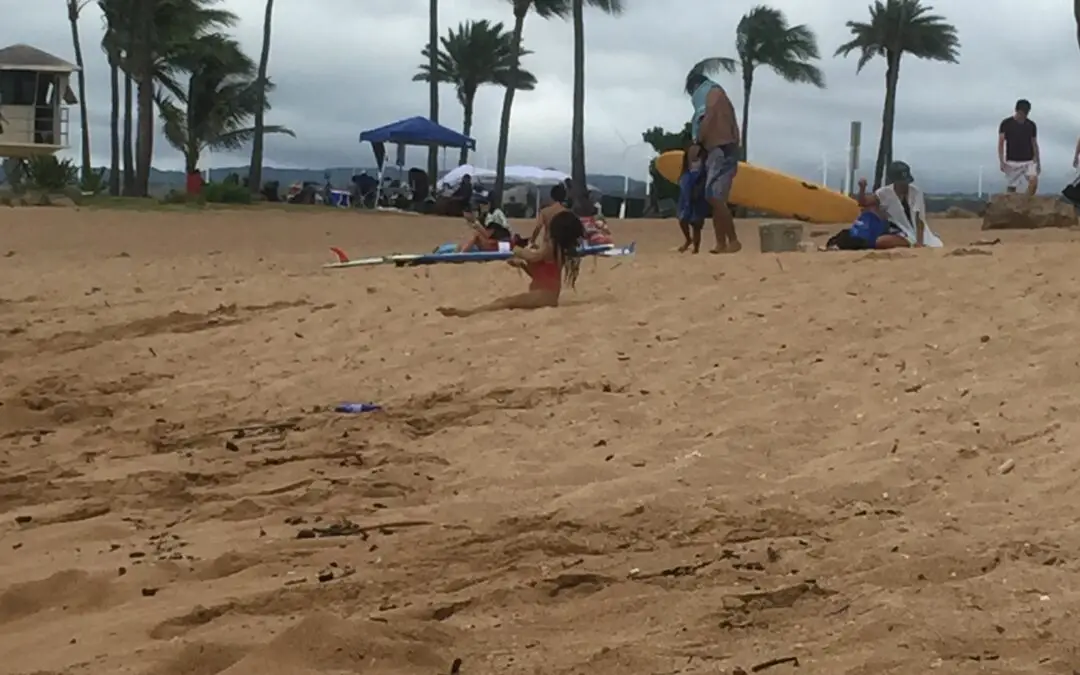Geckos, centipedes, flying roaches, Portuguese man o’ – what?! From Hawaii’s idyllic rain forests to our captivating blue oceans, across must-see urban foodie hotspots to suburban family homes, roam all kinds of critters and creepy-crawlies. For the most part, most are not dangerous or venomous, but it is surprising when you find a thumb-length roach staring at you from the window or a big, red centipede slinking away when you pick up your shoe, so here we go! Please enjoy our intro guide to some of Hawaii’s local critters before your trip to Hawaii.
Are there really dangerous animals in Hawaii?
The short answer: No, not really. Well, not like bears in the forest or snakes in the jungle. Probably the most famous and only large predators of the Hawaiian Islands are sharks. However, the chances of a shark attack are literally one in a million, with the threat of a lethal attack even smaller. In fact, in terms of ocean dangers, the risk of drowning due to currents or unpredictable ocean conditions is a far more common occurrence.
However, even if you don’t have to worry about shark attacks, there are still a few creatures whose sting or bite might make your Hawaii vacation a LOT less enjoyable. Whether you are hiking, swimming, or just exploring the islands, the likelihood of encountering centipedes, fire ants, Portuguese man o’ war, or box jellyfish is a lot higher than facing a shark so here’s some info to help you avoid any unfortunate experiences with these critters. In addition, we’re tropical, so sometimes we have scary-looking critters that are mostly harmless; it might be helpful to know about these too! Anyway, for your reference, here are some of the good, bad, and/or ugly critters found in the Hawaiian Islands and what to do about them!
Welcome to Hawaii Wildlife 101
Let’s start with the painful critters.
1. Centipedes
So, I recently discovered that some of my friends on the US mainland did not know that centipedes bite. In Minnesota, all know about those *house centipedes* that ripple across the walls of basements, but those are different from Hawaii centipedes. And while I’m sure they’re cousin species or something, aside from the gazillion legs, I want to let you know upfront:
Hawaii centipedes bite…and when they do, they hurt like crazy.
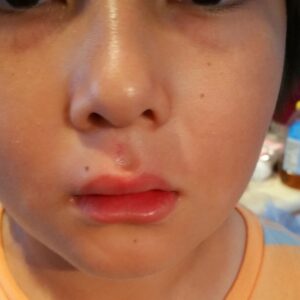
My oldest was bitten above his lip while he was sleeping by a centipede smaller than a quarter.
Okay, saying that I’ll admit that I’ve never been bitten. This is a miracle since I’ve – TWICE – had a centipede crawl all over me (repeatedly) – once while I was stuck as a passenger in a car driving on H1 Freeway and another time when I was in bed. I even accidentally grabbed it! Eek! (shivers). Unfortunately, my oldest child and husband, have both been bitten more than once inside our house and they looked and felt awful for about 24-48 hours afterward. My poor baby was bitten on his face! We couldn’t figure out why he woke up with a sharp pain coming from his lip; then it started to swell up and we noticed little “bite marks” so I began lifting up and shaking out his blankets and bedding. We found it squashed under a pillow – a tiny quarter-length blue centipede bit him while he was sleeping.
How common: If you are hiking, sitting in the grass, or even walking on a sidewalk in a Hawaii suburb, there’s a chance you’ll at least see a centipede while in Hawaii. Here, we have the honor of having THREE types of centipedes – red, blue, and yellow – and unfortunately, they ALL have venomous bites. I’ve seen all three, but the big dark red ones are the most common. I’ve read those dark red centipedes can grow up to 12 inches, but I think many I have seen are between 4-6 inches in length.
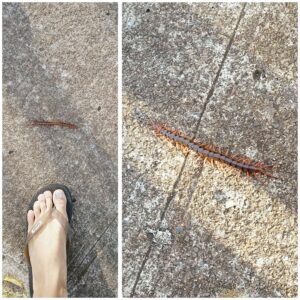
Just a typical red centipede cruising down a sidewalk.
How to avoid: Centipedes like dark, damp areas so try to avoid lifting up rocks or decomposing leaves when hiking. Also, if you go to a beach with lots of pine needles on the grass…they seem to love crawling through that. Most often, centipedes will just scurry away when exposed…you just want to make sure they scurry away from you not toward your sandal, shoe, or up your pants. This can happen quicker than you expect because those critters are super-fast! Centipedes also like the damp grass and I’ve sometimes seen them weaving through a lawn or grassy field at night or in the early morning dew.
A word of warning, DO NOT try to kill them by stomping on them. They are tough buggers and I’ve even seen one do a funky ninja move and flip halfway over while being stepped on, biting/stinging the person anyway…although to be fair, the guy was wearing slippers, so it probably wasn’t the best time for him to attack a centipede.
Okay, so assuming you want to avoid these critters, do these things when you’re out and about in Hawaii:
- Make sure you shake out your bag, towels, blankets, and any clothes you put on the ground when you’re at the beach or on a hike. While it’s totally common to leave your bags and towels lying around near a tree or on a bench, it’s also an easy way for a centipede to crawl in. Then later, when you’re nice and relaxed back in your hotel room (or car), it’ll come out and say “hi.” I’m pretty sure that’s how that centipede ended up in the car when it crawled over my (sandaled) foot. We had gone to a beach on the weekend threw all of our things in the trunk when we went home, and the centipede appeared on my foot a couple of days later (it was probably working its way from the trunk to the front of the car…to say “hi”).
- If you’re going to an outdoor event – i.e. evening concert or movie night – just be mindful of anything crawling around. Centipedes will sometimes roam through the grass at night, but so do little roaches, beetles, and other non-biting critters. (Sorry, Hawaii has bugs ????).
- Don’t lean against trees without looking first. I’ve seen centipedes crawling up tree trunks and I think they like to nest in the crevices and nooks of trees.
- If you’re staying in a rental home (instead of a hotel room), it might be a good idea to shake out your bedding – unfortunately, it’s quite easy for them to sneak into a house through natural cracks and crevices and I’ve heard of a lot of centipede encounters that take place in bedding.
- Whenever you remove your shoes outdoors or near the outdoors, shake them out – especially if you take them off while on a hike, at the beach, park, or outdoor patio.
If you do get bitten, don’t panic. It’ll hurt like crazy but it should get better in 2-4 days. If it becomes unbearably painful or if it feels warm and gets very swollen, go to a hospital – it could be an allergic reaction or an infection. Once the pain subsides, congratulations! You can join the SBACC (Stung By A Centipede club) – my brother corrected me and said they actually “bite” not “sting” but I didn’t make up the name of the club so…LOL.
2. Fire Ants
There are several kinds of stinging ants in Hawaii and while they’re usually just irritating, we also have two species of fire ants – the tropical fire ant and the little fire ant (LFA). These pack a stronger sting and can sometimes cause welts, hives, or even blindness in pets (if they sting the eyes).
I don’t think I’ve ever come across the little fire ant but I’m pretty sure I’ve tangled with the tropical fire ant and their sting is painful and left marks on my feet for a day or two, but I could still walk around. In my case, I accidentally ran into a nest at a grassy area of a beach park and another time at a park while watching my daughter’s soccer practice. The sting does pack a punch – especially since the ants themselves are SO tiny – and I had welts from the bites, but otherwise, I was fine. If you have small children, however, I would just exercise some caution as the stings will probably feel more painful for them. For a while, my youngest son was an ant magnet and was stung by ants more than once. Being stung by fire ants at 3 years old, however, really scared him and caused welts on his arms and legs. We had a doctor check him out and he was fine, but it made him fussy and overly cautious of ALL ants for a while.
How common: Ants are always around but in all the years I’ve lived in Hawaii, I’ve hardly come across biting or stinging ants. In general, while I don’t think this critter will be much of a problem, in case you are stung, just know that it can be painful but will the immediate pain subsided within a couple of hours with stinging and itchy welts lasting for a couple of days. If you get welts as we did, we used a hydrocortisone cream to counter the itching and reduce swelling, but check with your doctor to avoid the wrong treatment. If you are stung by the LFA you may have a more painful reaction; I would consult a doctor if needed.
How to avoid: Tropical fire ants nest in the ground – in either dry or moist soil but they don’t always build mounds (this was why we didn’t notice them at first). They are often found near roadsides or in beach parks. The little fire ants are newer to Hawaii and more detrimental to the environment, people, and pets – they are, however, not as common as the tropical fire ants so it’s even less likely you’ll run across them. They can be found on the ground and in trees in humid or damp environments; they have been known to fall on unsuspecting people, stinging them when agitated.
3. Scorpions
Hawaii is home to a non-venomous lesser brown scorpion. These are so uncommon that many people (myself included) don’t even know we have scorpions in Hawaii. Unfortunately, now I know and…I still hope I never, ever see one! LOL. Hawaii scorpions are usually outdoor critters but they can sometimes make their way into homes, typically seeking the dark spaces of garages, sheds, and under houses, but they have been found in hidden corners or under sinks as well. While they aren’t poisonous, the wallop of a sting has been compared to a sting from a wasp or yellow jacket. Hopefully, like me, you can enjoy your time in Hawaii blissfully unaware that these critters even make Hawaii their home!
4. Box Jellyfish and Portuguese Man O’ War
If centipedes are the critters to avoid on land, then box jellyfish and Portuguese man o’ war are the critters to avoid in the sea.
Let’s start with Box Jellyfish. While there are some extremely venomous box jellyfish around the world, in Hawaii, box jellyfish stings are pretty mild. And while it might cut some of your vacation activities short, except in very rare cases (usually when an allergic reaction is involved), it won’t be life-threatening. Box jellyfish in Hawaii are quite tiny, between 1-3 inches, and when they’re in the water they’re practically transparent. It is unclear if the sting of the Hawaii box jellyfish or of the Portuguese man o’ war is worse. Hopefully, you’ll never have a chance to experience a cross-comparison!
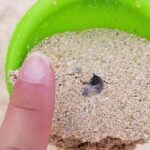
So tiny but it can still sting!
Next, the Portuguese Man O’ War. Often Portuguese man o’ war are mistaken for jellyfish – I mean they have tentacles, bubble heads that float on/near the surface of the water, and trap fish with their tentacles. However, they are actually part of the siphonophore species, a critter closely related (but not the same) to the jellyfish. While Portuguese man o’ war have a strong sting, they are also rarely fatal to humans.
How common: The appearance of box jellies and man o’ war are pretty common on Hawaiian beaches. I wouldn’t say I see one every time I go to the beach, but it’s good to keep an eye out, especially because both box jellies and man o’ war tentacles can still pack a strong sting even when they are dead and washed up on the beach. This might be good to note since small children may see the colorful Portuguese man o’ war bubbles and try to pick them up. The blue bubble body doesn’t hurt, but the tentacles below might stick to their arms or legs and sting them. Unfortunately, I’ve seen it happen before. In terms of spotting them in the ocean, ah, it’s hard – the box jellies float a little below the surface and even the floating Portuguese man o’ war are difficult to see when floating in the water.
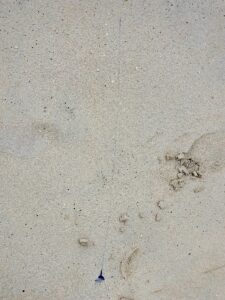
A Portuguese man o’ war including it’s longest tentacle.
How to avoid:
- Box Jellyfish have a predictable schedule and tend to show up according to the moon cycles, usually about 8-12 days after a full moon. However, weather can sometimes affect the pattern, so check the evening news or website since they often mention if box jellies or man o’ war are coming and what beaches will be impacted. This calendar from the Waikiki Aquarium is also helpful.
- Pay attention to the yellow signs posted on many of the beaches. These signs warn beachgoers about anything from jellyfish sightings to strong currents to bacteria in the water.
- Portuguese man o’ war do NOT have the same kind of predictable schedule as box jellyfish. You’ll need to pay attention to signs at the beach. Also, if you notice a lot of little blue bubbles washed up on shore, you can decide if you want to venture into that water that day (many people still do!).
- In the case of Portuguese man o’ war, check the shoreline for little blue bubbles. If you have kids, make sure they avoid touching them as jellies and man o’ war tentacles can still sting even when they are dead.
- Ask the lifeguards on duty.
Overall, while you can take precautions, the fact is, both box jellies and Portuguese man o’ war are part of Hawaii’s natural ocean environment so if you decide to go to the beach, there’s always a chance that you may be stung. That being said, no one in my family has ever been stung, even though we have occasionally come across man o’ war washed up on the sand. And, sometimes it’s just (bad) luck – my daughter has never been stung but one of her friends gets stung almost every time they go to the beach together! Also, it’s very common to see signs posted and man o’ war washed up on the beach, but still see a ton of people happily playing in the water.
If you do have the misfortune of being stung, while they do pack a punch, unless you have an allergy, the impacts are not life-threatening. There is a TON of advice on the internet but I think this one is the best – it has been researched by the University of Hawaii and summarized really well by Maui Ocean Center.
Treatment from jellyfish or Portuguese man o’ war tentacle stings:
- Rinse the affected area with vinegar because it prevents the stinging cells from firing (if you try to scrape them off, you could activate even more of the stinging cells.)
- Instead of scraping, remove residual stingers with tweezers.
- Apply heat (not ice) as it lowers the venom.
An unofficial tip. My friend (and former boss) who’s an avid beach-walker, kayaker, and overall Hawaii outdoors person swore up and down that using the liquid from the naupaka berries over the stings relieved the symptoms better than anything else she’s ever tried (and due to her lifestyle, she’s been stung a lot!) I found a little information online, but she’s the only one who’s told me this, so it’s up to you if you want to try. Please just take what you need and do not destroy the plants! The beach naupaka plant has half-flower blossoms and white berries. Squish a berry so the liquid comes out and use it on the areas that have been stung. (If you are experiencing an allergic reaction, however, just go to the hospital ASAP.)
Preventative care: While looking for something totally different on Amazon, I came across a lotion you can put on before going in the water! It’s supposed to help reduce the effects of the stinging tentacles if you happen to encounter a jellyfish or Portuguese man o’ war. Unfortunately, I haven’t tried it myself but this article from the National Library of Medicine seemed to back up the use of this kind of product to help prevent jellyfish stings. It looks like a good option so I’m linking the products from Amazon. Just note that one has SPF and one that does not have SPF so you would need a separate sunscreen.
5. Other ocean critters
While I think jellyfish and Portuguese man o’ war are the most common sea critters you’ll probably encounter in Hawaii if you’re planning to visit tide pools, snorkel, or scuba dive, here are a few more that you may encounter.
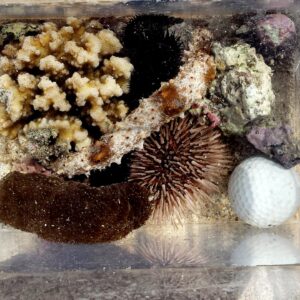
Can you find the black sea urchin (wana) here?
Wana: Wana – pronounced as “va-na” – is a poisonous sea urchin you may see while visiting Hawaiian tide pools or snorkeling out near the reefs. They’re very striking with their all-black (or dark purple?) coloring but can be difficult to see if the water is churning or if they’re partially tucked between rocks. Some of their spines have toxins that can break off in your skin if stepped on – these can cause painful, burning puncture wounds and may require a doctor’s care to make sure the spines are completely removed. This is really important since the spines are brittle and can break into small pieces when you’re trying to remove them yourself.
We recommend wearing water shoes or old sneakers when walking around tide pools and foot protection when snorkeling. This will also protect your feet from sharp rocks and coral.
Eels: Okay, the chance of being bitten is extremely rare – in fact, eel bites aren’t even officially tracked – because eels are typically not aggressive and avoid people unless provoked. However, eel bites can be quite nasty – my friend’s father was bitten and it wouldn’t let go of his arm (or so I was told) – and can cause serious injury and infection.
Avoid sticking your hands or feet in crevices of rocks or coral while exploring tide pools, snorkeling, or scuba diving; this will significantly reduce the chances of being bitten by an eel. It is also good to avoid areas where people are fishing since it’ll draw out eels looking for a meal.
Sharks: For new visitors to Hawaii, I think one of the biggest concerns is sharks and shark attacks. I know quite a few of my Midwest friends who swore they would never swim in the ocean because of their fear of shark encounters (Jaws, anyone?). But, the fact is shark bites are extremely rare – on average there are about 7-8 bite situations per year in the Hawaiian Islands – this includes fatalities as well as situations where the incident was considered provoked by the person (i.e. swimming with sharks, trying to remove a shark from a fishing net or fishing line, etc.), and situations where a shark ended up biting a board or fin instead of the person. Even though I’ve been in Hawaii most of my life – as well as paddled in Hawaiian outrigger canoes during high school – I have never seen a shark live (except at an aquarium or sea park). I have seen small eels, sea turtles, and even sting rays in the ocean, but never sharks.
While I think it is more likely you’ll encounter jellyfish/man o’ war and centipedes than sharks, here are some tips to keep safe (from sharks) for your peace of mind:
- Pay attention to the yellow signs posted by lifeguards at the beach. If there was a recent sighting of a shark in the area, there will be a sign about it – sometimes they may temporarily close the beach as well.
- Avoid swimming at dawn or sunset since visibility is low and some shark species will move closer to the shore to feed at night.
- Always swim with a buddy. This is one of the things I emphasize the most with my kids. Always swim, hike, go out, etc. with a buddy – it just makes sense to have someone with you in case of emergencies.
- Don’t swim where people are fishing. Sharks have a great sense of smell and all the fish and bait in the water make it more likely they’ll mistake you for food too!
- Avoid murky water, harbor entrances, and steep drop-offs. If you’re not sure about the situation, ask a lifeguard.
- This leads to…if it’s possible, swim at beaches with lifeguards – they know if there are riptides, drop-offs, or anything dangerous, plus they can help if there’s an emergency. Here’s a list of all Hawaii beaches with lifeguards.
6. Mosquitoes
I think Hawaii mosquitoes are sneaky because I just can’t feel them when they bite! I hated the Minnesota ones but I could almost always feel the pinch so they were easy to swat away. In Hawaii, I’ll suddenly look down and I’ll have a couple of mosquitoes hovering around my legs (and I’m not even as “yummy” as my husband and kids. They get bitten about 2-3x more than I do, poor things. I they get the itchy welts. Outside of being irritating pests, you don’t have to worry too much about diseases like dengue, Zika, and chikungunya in Hawaii because the likelihood of being infected is currently very low. In Hawaii, we do have the type of mosquitoes that can carry those diseases, but none of them carry them right now. So far, all cases have been via infection through exposure out of state. That being said, if you have been traveling to a high-risk area, please take the proper precautions so that Hawaii continues to be free of dangerous diseases like Zika, dengue, and chikungunya. You can check our Hawaii.gov site for current information regarding mosquito-transmitted diseases.
Due to our tropical environment, It is highly recommended that you wear mosquito repellent while out outdoors and especially when hiking, visiting botanical gardens, or toward sunset (it seems the mosquitos go nuts around that time). We have used bracelets, stickers, sprays, and balms but I think a combination of bracelets and spray works best. The kids really dislike the spray, but it’s way better than having them scratching their skin like crazy when they get bitten (3 of my kids get itchy welts when they’re bitten – like hubby — and one of them is like me and hardly gets bitten because…good genes. Just kidding. LOL.)
7. Misc: Leptospirosis and Rat Lungworm disease
I think these two diseases are worth mentioning because, although they are not exclusive to Hawaii, they can be transmitted by doing things that locals and tourists would typically do in Hawaii, namely swimming in waterfall ponds and streams near hikes and eating fresh vegetables or fruits, or maybe drinking from a fountain or freshwater source while hiking or at the beach.
Leptospirosis: Leptospirosis is a bacterial disease that causes headaches, fever, chills, rash, muscle pain, jaundice, abdominal pain, vomiting, and more. Often it can be mistaken for other diseases so it can be hard to diagnose right away. In Hawaii, you can get leptospirosis by swimming or wading through freshwater streams and ponds that are contaminated by animal urine. It is transmitted via cuts or even by coming in contact with your mouth, eyes, or nose. While it is treatable with antibiotics, if left undiagnosed or not treated, it can cause kidney or liver damage and potentially death. There are about 100-200 cases in the US per year, and about 50% of these occur in Hawaii.
To minimize your chances of getting leptospirosis, it’s important to do the following:
- Be careful if you choose to enter a freshwater stream or pond. Do NOT enter if you have any open cuts. Also, I don’t recommend putting your head underwater since the bacteria can enter through your mouth, nose, and eyes.
- Do not drink pond or stream water.
- Read signs posted by waterfalls and waterholes – sometimes if there were cases of leptospirosis or the water has been contaminated, there will be signs telling you not to swim or enter the water.
- Avoid coming into contact with freshwater run-off from streams or ponds after it rains. The rain will bring animal feces and urine down the mountains via streams and waterfalls.
Rat Lungworm disease: Honestly, even though it’s been around the Hawaiian Islands for a while, the first time I heard of this parasite was when I moved back to Hawaii in 2013. Frankly, as a kid, we used to do so many things that could have transmitted this disease, but fortunately, it wasn’t as common (and maybe we just had dumb luck!). Regardless, this little parasite is like straight out of some freaky sci-fi movie and, although it isn’t likely, I hope no one ever, ever gets this because…well, let me explain. This parasite often infiltrates rats and then its larvae transfer to frogs, slugs, and centipedes when they consume rat feces (wild animals and pets can also get infected if they eat infected frogs, slugs, etc.). In Hawaii, rat lungworm disease is contracted when this parasite is transferred to humans when they eat raw or undercooked snails or slugs, consume raw produce that contains an infected snail or slug (or part of one! Barf!), drink from a garden hose that may have a resident slug or snail inside it, and/or drink from rainwater catchments that have an infected slug or snail in it. For some areas of the Big Island, rainwater catchments are the primary source of fresh water so they need to make sure the water is closed off to prevent slug or snail contamination.
So, the bad part is there is no cure. While the parasite cannot reproduce in a human host, it can cause a ton of temporary and(sometimes) permanent damage until it dies. In fact, it can cause so many issues, it can be difficult to diagnose, with symptoms ranging from flulike symptoms, nausea, vomiting, headaches, neck stiffness, and nerve pain, as well as neural and ocular damage because this parasitic worm could eventually travel to your brain and stay there until it dies! [insert horror movie screaming here.] In some cases, it can cause comas and death.
However, there’s also good news! In Hawaii, it’s quite rare – about 8-10 cases per year – AND once you know what to avoid, you’ll know how to significantly decrease the chances of getting the parasite and disease.
- Make sure to wash your hands (and fingers!) very well after playing outdoors. Some of the slugs that carry the parasites are very, very small (like the whites of a fingernail-sized). If you or your children are playing in the dirt or with plants in a garden, it’s possible to come in contact with a snail or slug without even knowing it.
- Wash (and wash again) all fresh produce before consuming – lots of fruits and veggies have folds and crevices so make sure to thoroughly clean between the folds of lettuce or near the stem of fruit before you eat it – soap, bleach, salt, vinegar or whatever produce wash you use will not matter, the slugs need to actually be washed away and off the produce. (Even if the slug or snail is dead, the parasite may still be alive unless heated or frozen.)
- If concerned, heat or freeze your veggies – cooking veggies to at least 165 F or freezing them for over 48 hours to kill the parasites.
- Check your bananas. Slugs love bananas so it’s important to make sure that you do not consume any part where the skin is open and the banana flesh has been exposed.
- Cook/boil any snails or freshwater prawns for at least 5 minutes before consuming.
- Do not let your children play with slugs or snails. This seems self-explanatory but Hawaii has these very large African snails which are sometimes fascinating to children – often, they want to pick them up by their shells. If they accidentally do, don’t panic. Just help them wash their hands thoroughly as soon as possible with soap and water.
- Do not drink from a garden hose. This one is sometimes hard for locals to remember as I think many of us grew up believing that Hawaii water is very clean and, since it gets hot, we would often play in garden sprinklers, rinse our faces with hose water (and kind of drink it), and think nothing of it. << NOT GOOD!
The symptoms of rat lungworm disease are hard to gauge because they can show up anywhere from a few hours to a few weeks after ingestion. However, by following these kinds of guidelines, it is unlikely that you will need to be concerned – education and awareness go a long way toward prevention. For example, in one Hawaii case, someone ingested a slug on a dare. In another local case, a group of people became infected when they consumed a beverage (raw kombucha, I think) and found slugs at the bottom after the fact. These situations happened before everyone realized the possibility of contracting rat lungworm disease was a real and serious concern in Hawaii. I mean, having slugs accidentally enter an open beverage or even eating a slug on a dare (yuck) might have been gross but I don’t think anyone was expecting it to be life-threatening.
Anyway, the bottom line is that rat lungworm disease is very rare but just requires a few precautionary steps so you can enjoy your Hawaii vacation worry-free.
Critters that look dangerous but…
*If you are staying in a high-rise hotel, I don’t think you have to worry about most critters (especially on the higher floors), however, when you’re walking around the pool or gardens of a resort or dining around town, chances are you may encounter a roach or gecko. If you’re hiking, exploring a botanical garden, or a historic site, you may see a wild pig, roach, gecko, or cane spider. Just know that while some may look scary, they aren’t poisonous or too dangerous.
8. The cockroach

We even have a children’s book about roaches.
Ha.Ha.Ha. Locals in Hawaii, love to talk about our crazy, flying roaches – there’s even a children’s book about them! I admit, we sometimes use these stories as jokes but, truthfully, most of us will avoid them too. Some of us (possibly, frequently me) will literally avoid a room or cross a street to avoid walking near one. With Hawaii’s warm climate, we can’t help having roaches (they have been around for over 280 million years after all) and whether we like it or not, they will often infiltrate our homes, our outdoor spaces, or both. In Hawaii, no matter how much we treat, spray, or trap, no place is totally bug-proof in Hawaii and I’ve seen a big roach wander in just about anywhere – from tiny, old, wooden plank homes to multimillion-dollar mansions. What can I say, sometimes they just like to stop in and say, “Hi.”
So, with that in mind, if all you see is a random stray small roach, feel free to do what you’d like – you can spray, trap, or ignore them. With the big, flying ones, I personally think it’s easiest to leave them alone unless they’re blocking you from a place you need to be. If they’re on a wall or ceiling, I wouldn’t recommend spraying them as the spray could get in your eyes or nose. Also, they tend to dive-bomb toward your head if you don’t kill them on the spot. If they’re on the ground, I’d say you have the advantage, so I usually just spray them…a LOT or ignore them. I pretty much never step on them…too juicy. Yuck. Anyway, they’re not dangerous, just…roaches, so good luck!
9. Cane Spiders
Ah, the big, fuzzy spiders that look so intimidating but are actually helpful…though I wish they could be helpful far
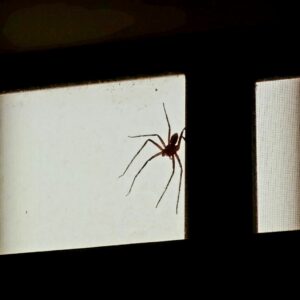
Cane spider in our bathroom window.
away, not popping up in my bathroom at 3 AM. Ugh. In my experience, cane spiders pretty much mind their own business so while you’re more than welcome to go at ’em, I made a personal decision a long time ago to simply avoid them…in Any. Way. Possible. So, if I happen to find one planted right in the middle of the laundry room looking like a boss, blocking my way to the garage and my car. I just avoid it. That day will suddenly be the perfect day to walk around to the front of the house, cross the yard in my nice shoes, squeeze past the recycling bin and garden hose on the side of the garage, and jump over the old rake to get to my car. See? Avoid-avoid-avoid.
Now the likelihood of seeing these critters is low unless you’re visiting an area that used to be sugar cane fields (hey, just like my family’s house!) or a store or historic site located in a rural area. Even then, the possibility of seeing one is slim because they are nocturnal hunters. They will usually freeze in place or run away — up toward a wall or ceiling if you find it in your home — and may only bite if seriously provoked (I’ve never really been close enough to find out). They can kind of jump, so I really try not to get too close.
Now, as for the other reason I don’t try to kill them (besides being too afraid to)? It’s because they are great at catching roaches and other small insects that may sneak into the house. So really, we’re like allies! Very socially distant allies!
10. Snakes
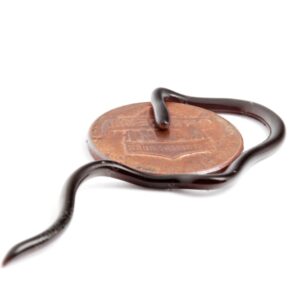
The Hawaiian Blind Snake is about as small as a worm.
Okay, so Hawaii does have a snake, it’s not indigenous, but it has been around for a while and it’s….dare I say, cute? Also known as the Hawaiian Blind Snake, Hawaii’s little black snake looks more like an earthworm and is non-venomous. I have never seen one personally, and believe me, I’ve tried…although my grandma probably didn’t appreciate me poking around her plants. LOL. They’re the size of earthworms, but black in color and you might be able to find them around potted plants, compost bins, and gardens, but otherwise, there isn’t much more than that. Oh, it’s illegal to own snakes in Hawaii because of the potential havoc they could wreak on Hawaii’s indigenous endangered bird species and the overall Hawaiian ecosystem – you can be fined up to $200,000 and have a 3-year jail sentence if you sneak a snake to the Hawaiian Islands. As for the Hawaiian Blind Snake, this little critter has been deemed harmless (and cute!) <–Okay, that just might be me.????
Ah, I never knew Hawaii has sea snakes, but if you include them, then Hawaii is also home to a venomous yellow-bellied sea snake; this type of sea snake is found in tropical ocean waters around the world. They are less than 3 ft. long and not aggressive. In addition, in Hawaii, they are so uncommon that even documentation of snake sightings is poor and not well recorded – I couldn’t even find a YouTube video of this sea snake in Hawaii! To date, there have been no reported fatalities involving this yellow-bellied sea snake in Hawaiian waters.
11. Geckos
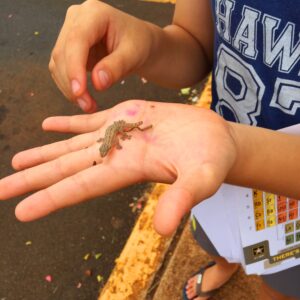
Yes. If the gecko gets startled, it may drop part of its tail.
Growing up in Hawaii, geckos were just around (kind of like roaches, but cuter) so I was really surprised to learn that some of my mainland friends were so freaked out by the idea of geckos just existing in your house with you (well, they’re not there all the time, but I was never surprised or grossed out when I saw one a wall or near a window). Whether you like the little lizards or not, it’s very common to see a few varieties of geckos in Hawaii, both in and out of your home or hotel…and you’ll definitely see them climbing on the rock walls of a Hawaiian resort or when you’re out and about. You’ll probably hear them before you catch a glimpse of one because geckos are famous for making these clicking/chirping sounds as a defensive or communication alert. Plus, they’re great to have around because they eat the moths, termites, roaches, and other bugs that might get into our homes. In our experience, they tend to leave people alone but, some are curious enough to get close to you and even eat something from your hand if you let them. As a kid, I used to catch them and put them in those little plastic bug/fish aquariums and try to feed them bugs…for like a day and then let them go. Anyway, my point is, they are not dangerous.
12. Wild Pigs
Okay, in all seriousness, wild pigs are NOT ‘harmless’ but I’m putting Hawaii’s wild pigs in the “not dangerous” category because overall, these animals aren’t aggressive and if you’re staying in a hotel or resort, you’ll probably never see one. If you’re vacationing in a rental home or visiting friends, depending on where you are staying you may come across wild pigs, so this is just some basic information in case you do. Unfortunately, in recent years, their populations have exploded on the islands, leading to overpopulation and more aggressive and bold behavior due to their larger roaming groups, fighting over food, and protecting their young.
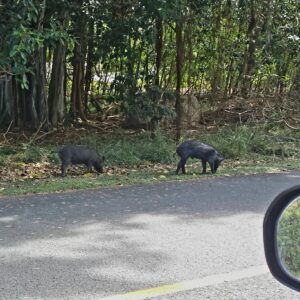
This is as close to wild pigs as I’ve ever gotten.
I have only seen wild pigs on the side of the freeway, so I’ve never been close enough to be concerned. While hiking, I have heard certain trails might have a sighting or two, but between me and my friends who are avid hikers, I think I’ve only heard of one or two instances where someone had a few wild pigs near their trails. At the same time, there are a few suburbs where sightings are becoming a little more common, especially in neighborhoods near wooded areas along the mountain ranges.
With this in mind, please be aware of the following:
- If you find wild pigs in the yard of your Airbnb or while you’re hiking, don’t try to chase them away on your own.
- Also, DO NOT feed them! They will keep coming back to the area which is beginning to cause a lot of damage to the mountainside, including excessive erosion.
- Keep calm. You don’t want to startle them.
- If you are hiking keep to the trails and avoid areas that look trampled and dug up (this is probably the activity of wild pigs searching for food.
After reading about cases of wild pig activity in different parts of the US, I don’t think Hawaii wild pigs are nearly as aggressive as wild pigs in other states and countries; they might also be smaller. However, be safe during your vacation and err on the side of caution.
If you are interested in hunting wild pigs, you’ll need to visit the Hawaii Department of Land and Natural Resources to learn how to acquire a permit – it may take a while, so plan ahead if needed.
13. Kangaroos!?
LOL. Okay, this one caught me totally off-guard (more than the scorpions or the yellow-bellied sea snakes) because…What?! How?! Apparently, Oahu has kangaroos (or more specifically wallabies)! If other animals and critters are rare, spotting one of Hawaii’s kangaroos is nearly impossible (that’s not a challenge, just a fact!). Apparently, over 100 years ago, they were brought over as part of a private zoo collection and then, at some point, they escaped. If that is the case, then they only live in a small section of a valley near Honolulu. It is believed there are only about 40 wallabies in total and while I would totally love to see one, I’ve read that, for most people, our chances are near zero due to their shy nature as well as because the land they occupy is on private property. In addition, the only way to access the property (which you shouldn’t because it’s private) is via a military base.
So, if a Hawaii wallaby happens to stray into an area where you can catch a glimpse of one, then, congratulations! — you might have just seen Hawaii’s equivalent of a unicorn!
What do you think?
So that’s it. In the beginning, I was just going to write about the “dangerous” animals and bugs in Hawaii for safety reasons when traveling to Hawaii, but then I realized there are a lot of other interesting critters in Hawaii. And even some might even look dangerous but they’re not; even better, while learning about different critters in Hawaii, I learned about different animals that I didn’t even know lived in the Hawaiian Islands. I didn’t get into it, but on Maui and the Molokai, I think there are also deer as well! It’s amazing to know that somehow, we all ended up living on these small islands in the middle of the Pacific Ocean. ❤️????️

